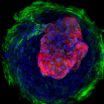Damage to key brain region important in predicting cognitive function after pediatric TBI
2015-07-15
(Press-News.org) Disruptions in a key brain region can explain the varied outcomes after a traumatic brain injury (TBI) in children and adolescents, according to research published July 15 in The Journal of Neuroscience. Post-injury outcomes vary widely, and injury severity can only explain some of this variance. Combining data from brain imaging and recording, researchers at the University of Southern California and UCLA found that disruptions in the structure and function of a brain region called the corpus callosum could explain the variance in cognitive outcomes.
TBI is the leading cause of death and disability in children and adolescents. One of the most commonly damaged brain areas is the corpus callosum, a large band of nerve fibers that connects the two hemispheres of the brain. Damage to this area can cause cognitive deficits that can persist for years in some children.
For this study, the researchers used diffusion-weighted imaging (DWI) to assess the structural integrity of the corpus callosum in children and adolescents who had recently sustained TBI. To assess corpus callosum function, the researchers used electroencephalography (EEG) recordings to measure the amount of time it took for signals to spread from one hemisphere to the other during a visual perception task. Slower spreading times indicated poor function. The researchers found that:
Half of the TBI group had slow corpus callosum function, while the other half didn't differ very much from healthy controls.
The group with slow function had more structural damage in the corpus callosum and also performed the worst on cognitive tests.
Structural damage to and poor function of the corpus callosum were associated with poor cognitive performance.
While both the imaging and recording data could predict cognitive function alone, combining the two data sets improved the researchers' ability to predict cognitive outcomes. "Our results indicate that data from EEG and DWI can provide biomarkers for predicting outcome following moderate-to-severe TBI," said lead author Emily Dennis, a postdoctoral researcher at the USC Keck School of Medicine. This could help clinicians identify patients who are at higher risk for poor outcomes and for whom targeted therapies may be developed, the researchers said.
INFORMATION:
The Journal of Neuroscience is published by the Society for Neuroscience, an organization of nearly 40,000 basic scientists and clinicians who study the brain and nervous system. Study author Emily Dennis can be reached at Emily.Dennis@ini.usc.edu.More information on traumatic brain injury can be found on BrainFacts.org.
ELSE PRESS RELEASES FROM THIS DATE:
2015-07-15
Why do some youngsters bounce back quickly from a traumatic brain injury, while others suffer devastating side effects for years?
New UCLA/USC research suggests that damage to the fatty sheaths around the brain's nerve fibers--not injury severity-- may explain the difference. Published in the July 15 edition of the Journal of Neuroscience, the finding identifies possible biomarkers that physicians could use to predict higher-risk patients who require closer monitoring.
The study is the first to combine imaging scans with recording of the brain's electrical activity ...
2015-07-14
WASHINGTON, DC, July 14, 2015 -- When a sound wave hits an obstacle and is scattered, the signal may be lost or degraded. But what if you could guide the signal around that obstacle, as if the interfering barrier didn't even exist? Recently, researchers at Nanjing University in China created a material from polyethylene membranes that does exactly that.
Their final product, described this week in the Journal of Applied Physics, from AIP Publishing, was an acoustical "metamaterial" with an effective density near zero (DNZ). This work could help to endow a transmission ...
2015-07-14
A quick biological test may be able to identify children who have literacy challenges or learning disabilities long before they learn to read, according to new research from Northwestern University.
The study, publishing in the Open Access journal PLOS Biology on July 14th, centers on the child's ability to decipher speech -- specifically consonants -- in a chaotic, noisy environment. Preliterate children whose brains inefficiently process speech against a background of noise are more likely than their peers to have trouble with reading and language development when ...
2015-07-14
A yearlong study of more than 300 patients found that the investigational drug patiromer can reduce elevated blood-potassium levels--a common side effect of drugs essential in the treatment of chronic diabetic kidney disease.
The drug, given in this trial at one of four doses based on disease severity, returned blood potassium levels to normal when measured at four weeks and kept them under control for one year, the length of the trial. By quickly bringing potassium levels back to normal and keeping them there, patiromer can prevent life-threatening adverse events.
The ...
2015-07-14
The new guidelines for determining whether patients should begin taking statins to prevent cardiovascular disease issued in 2013 by the American College of Cardiology (ACC) and the American Heart Association (AHA) are more accurate and more efficient than an earlier set of guidelines in assigning treatment to adults at increased risk for cardiovascular events - including heart attacks and strokes - and identifying those whose low risk rules out the need to take statins. In their paper appearing in the July 15 issue of JAMA, a team led by Massachusetts General Hospital (MGH) ...
2015-07-14
An examination of the 2013 guidelines for determining statin eligibility, compared to guidelines from 2004, indicates that they are associated with greater accuracy and efficiency in identifying increased risk of cardiovascular disease (CVD) events and presence of subclinical coronary artery disease, particularly in individuals at intermediate risk, according to a study in the July 14 issue of JAMA.
The 2013 American College of Cardiology/American Heart Association (ACC/AHA) guidelines for the management of blood cholesterol represent a shift in the treatment approach ...
2015-07-14
A microsimulation model-based analyses suggests that the health benefits associated with the 10-year atherosclerotic cardiovascular disease risk threshold of 7.5 percent or higher used in the 2013 ACC-AHA cholesterol guidelines are worth the additional costs required to achieve these health gains, and that a more lenient threshold might also be cost-effective, according to a study in the July 14 issue of JAMA.
In November 2013 the American College of Cardiology and the American Heart Association (ACC/AHA) released new recommendations to guide statin treatment initiation ...
2015-07-14
Among patients with diabetic kidney disease and hyperkalemia (elevated potassium levels in the blood), a potentially life-threatening condition, those who received the new drug patiromer, twice daily for four weeks, had significant decreases in potassium levels which lasted through one year, according to a study in the July 14 issue of JAMA.
Patients at the highest risk for hyperkalemia are those taking renin-angiotensin-aldosterone system (RAAS) inhibitors with stage 3 or greater chronic kidney disease (CKD) who also have diabetes mellitus, heart failure, or both. Because ...
2015-07-14
An examination of state vaccination requirements for adolescents finds that the human papillomavirus (HPV) vaccine is currently required in only two states, many fewer than another vaccine associated with sexual transmission (hepatitis B) and another primarily recommended for adolescents (meningococcal conjugate), according to a study in the July 14 issue of JAMA.
Eight years after HPV vaccines were first recommended in the United States, vaccination coverage is substantially below the Healthy People 2020 target of 80 percent. Data from the U.S. Centers for Disease Control ...
2015-07-14
Berkeley -- Researchers at the University of California, Berkeley, in collaboration with scientists at the Gladstone Institutes, have developed a template for growing beating cardiac tissue from stem cells, creating a system that could serve as a model for early heart development and a drug-screening tool to make pregnancies safer.
In experiments to be published Tuesday, July 14, in the journal Nature Communications, the researchers used biochemical and biophysical cues to prompt stem cells to differentiate and self-organize into micron-scale cardiac tissue, including ...
LAST 30 PRESS RELEASES:
[Press-News.org] Damage to key brain region important in predicting cognitive function after pediatric TBI

